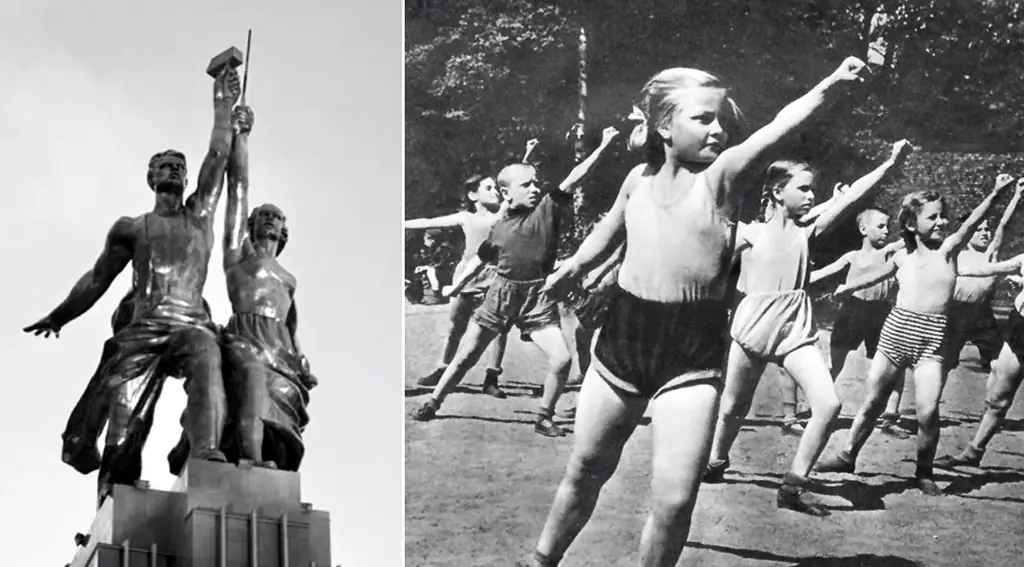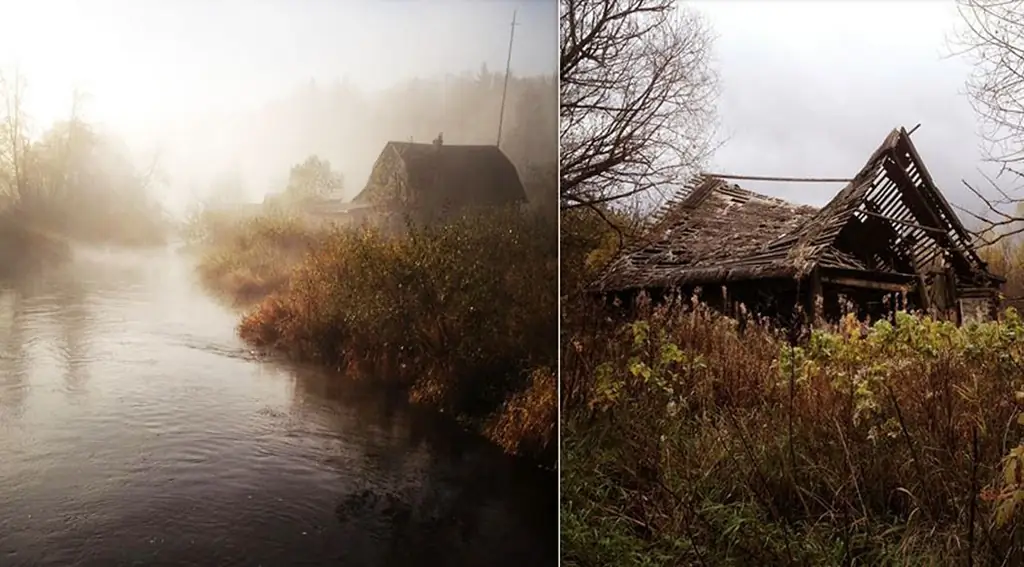- Author Adrian Jeff [email protected].
- Public 2023-12-17 05:06.
- Last modified 2025-01-24 14:09.
"Someone else's land", or There was a village … Part 3: "Symbiosis" of the working class and the peasantry
The famous sculpture "Worker and Collective Farm Woman" by Vera Mukhina became the personification of unity and a demonstration of the power of the working people, who, thanks to the revolution, took a leading role in the state hierarchy. For the first time in history, an ordinary person was raised to the very top of the state pyramid.
Part 1 - Part 2
The famous sculpture "Worker and Collective Farm Woman" by Vera Mukhina was not only a monumental symbol of the era and a powerful propaganda of socialist conquests in the USSR. She became the personification of unity and a demonstration of the power of the working people, who, thanks to the revolution, took a leading role in the state hierarchy. For the first time in history, an ordinary person was raised to the very top of the state pyramid.
He was exalted and praised not through his heroic peaceful and military exploits, as it happened later, already in the 70s, thanks, among other things, to the urethral Brezhnev. Then the muscle, always existing in two hypostases and alternating by necessity its states: from the monotony of "peace, labor, May" to the no less natural "noble fury" - was glorified in granite and bronze with names engraved in gold on the pedestals.

The muscle, always ready to "adopt" the form of the leader, is due to the nature of the proximity to the urethral. People with a muscle vector have their own enjoyment of realization, which lies in the efficiency of their physical efforts. For the sake of the pack, they grow crops, work on farms, build houses, and lay railways and pipelines.
The call to “feed the people” became a guide to action for the muscular peasant of the Soviet era. In this sense, the urethral and muscle stride together. The leader distributes according to the shortage the fruits of collective labor, created by the hands of rural workers, who perceive their lives only through us - a community, and not as something separate from everyone.
In his community, village, collective farm, consisting there with the whole family, in the forests and in the fields, where it is impossible to cope with floods or droughts alone in an unfavorable landscape, a muscular peasant feels the most favorable conditions for life.
In addition to the destruction of collective farms, state farms and their villages as a collective nucleus and the risk of general alcoholism destroying the muscle demographic mass, the widespread globalization of the world economy poses a threat to the food security of any country. The peasant, under the pressure of political and economic changes, reduces his economy and shrinks himself. You no longer need to worry about the sowing crop if bread is imported from other regions and countries.
An example is the current situation in Southeastern Ukraine, where, due to political unrest, local rural workers have not yet begun preparations for the sowing campaign, while their neighbors, Russians and Belarusians, have already begun. All this will immediately affect the market, price increases, etc., with all the ensuing consequences. In such a situation, one cannot speak of either food security or the successful development of agriculture.
This security can be ensured only if “the import of goods does not exceed 25% of domestic consumption. In Russia, however, it occupies 35% of the food market”(E. V. Maksimovskikh, Ural State Economic University,“Agrarian Question of Russia”).
If this happens, most of the muscles, having lost their main incentive - physical work and lacking the inclination and ability to organize the labor process, as they were suggested by fans of "individualism" in agriculture, either leave the village or drink too much, directing the demographic curve to zero, reducing the population of Russia. There are many more problems that the peasants themselves are not able to solve, since this is not their prerogative. New reforms and a new look at the collective economy are needed.

If you want to destroy the country, make the muscle an individualist
Almost thirty years ago, with the beginning of perestroika, a process was launched - the destruction of the integrity of the state, which was always strengthened and cemented by the people. The people are not some isolated, abstract unit. According to system-vector psychology, the demography of the population of any country is determined by people with a muscle vector. The muscle quota of each state does not decrease by itself, on the contrary, due to the tendency to have many children, it increases in the absence of wars and natural disasters. Since the time of perestroika, what can be called the purposeful destruction of the muscular demographic foundation, when collective farms began to recklessly switch to self-financing and self-sufficiency, has been taking place, destroying the most important thing - the experience of jointly planned work gained during the Soviet era.
As a result, according to statistics, most of the collective and state farms were disbanded, and 30% of the villages were deemed unpromising. This was the reason for the promotion of individual farms, that is, the revival of the kulak. Individualism, contrary to the main principle of the Russian mentality - collectivism, was the main prerequisite for depriving the muscles of their usual natural conciliarity, bringing fragmentation and separation. The collective muscular "we" was proposed to be replaced by the "I" alien to the village understanding.
The muscular ability to live communally, working and helping each other, allows the peasantry to be an organic landscape, to merge, akin to the land, "put down roots." People who have an anal vector are capable of becoming an individual entrepreneur on earth. At one time, the Stolypin agrarian reform was calculated for them, which in fact collapsed, turning out to be unsuitable and harmful for the common people - the muscle, skin and even anal population of the Russian Empire.
First of all, the peasants themselves opposed the Stolypin resettlement to Siberia. Driven from their homes, torn off from their patch of land and huts, tugged out of village communities, strong business executives, analogs, were sent to settle the Siberian lands and distant imperial outskirts. Thus, the reformers destroyed the main Russian peasant nucleus and moved, set in motion those strata of the rural population that could not be touched without exposing the communities, without accelerating the "de-peasantization of the peasants", without starting the proletarianization and lumpenization of the countryside.
The results of the Stolypin reforms outlined above are consonant with the situation that took place in the USSR in the mid-1980s, with the only difference that under Gorbachev, farms were simply closed, and the outflow of population to the city was more intense. The muscles remaining in the villages and hamlets fell under the influence of archetypal skin-dwellers, degrading and dying out. The strength of the state lies in collective survival, not in an individual economy, which is convenient in the tiny territories of Europe and murderous for Russia.
Returning to the film "Alien Land" by Nikita Mikhalkov and the questions raised in it about why the Russian village is dying and why Soviet agriculture has almost ceased to exist in just a few years, we can only add that the answer lies in the Russian mentality.

Until the state pays attention to the natural peculiarity of the peoples of Russia, any, the most expensive programs aimed at raising the countryside will turn out to be useless. Being guided by the Western model for the distribution of land for individual use, they do not solve the problem of the disappearance of Russian villages and do not contribute to the revival of agriculture, but further increase the tension in the country.
You can debate as much as you like, look for a way out of the situation, or even code from alcoholism who does not drink by nature, paradoxical as it may sound, of the muscle (some naively see this as a solution to the problem). But if emptiness and shortages continue to exist in the minds of Russians, some have an unrealized craving for work, and others have an archetypal desire for theft, then new drunkenness, hostility, self-hatred and hostility to their neighbor, their compatriot, will become their filling. The villages will still be overgrown with weeds, the number of homeless people, former villagers, within the city limits will increase, and the country's demographic indicators will rapidly fall down.
Nikita Mikhalkov certainly deserves respect for not bypassing this problem, talentedly and sharply exposing the gaping wound, earning many positive comments on social networks, forcing people to think about whether things are so favorable in their small homeland.
To stop the process of the destruction of the village, it is necessary to change the thinking in the heads of those who are responsible for the Russian national economy. This must be done quickly, while the continuity of generations of rural workers has not yet been completely lost. Lectures on system-vector psychology by Yuri Burlan can help in this.






